What Is A Hybrid Cloud Solution?
A Hybrid Cloud solution is a combined eco-system of storage that allows one or more (usually significantly large numbers) users to spread data across multiple storage hardware and services in order to access data in the most suitable method for that environment. Both 3rd party cloud providers and NAS hardware have their own pros and cons, but the two are not mutually exclusive, meaning you can use both systems to create either a multi-tiered backup solution, a Hot-Cold Storage system or BOTH, in a single office or in mixed geographic environments. What makes a Hybrid Cloud Solution different to just having a bunch of Dropbox accounts and a NAS at home is how the two INTEGRATE and COMMUNICATE data natively in the background with automated systems doing the leg work. QNAP’s new HybridMount platform and vJBOD platform are two great ways to create a mixed storage environment that gives you speed, access, security and ease.
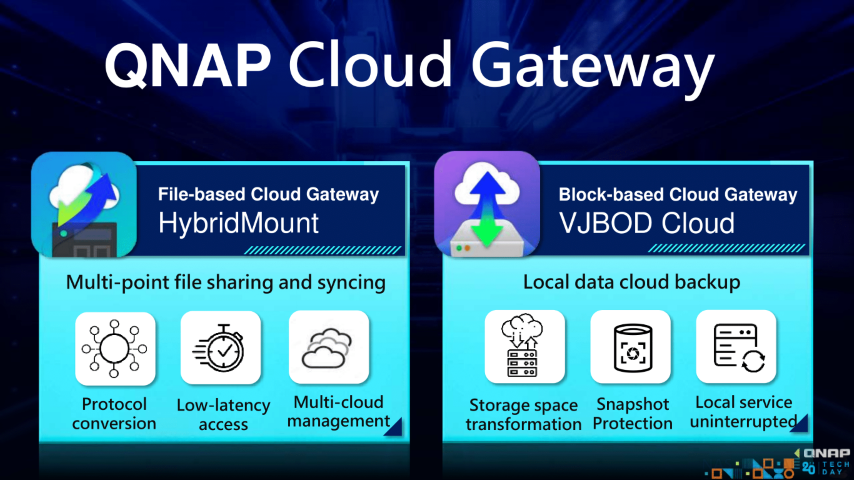
What Are the Benefits of a Hybrid Cloud Solution?
Hybrid Cloud solutions are enormously beneficial to companies and organizations that use wide arrays of client devices and operate in multiple environments throughout their team members. Perhaps it is users who have remained faithful to cloud providers (Dropbox, Google Drive, BackBlaze, etc) on more mobile devices, or perhaps that numerous hardware file systems are in operations for more than backups, but storage environments that contain NAS servers and Online cloud services together are becoming increasingly common. Both remote storage platforms have their own advantages, such as:
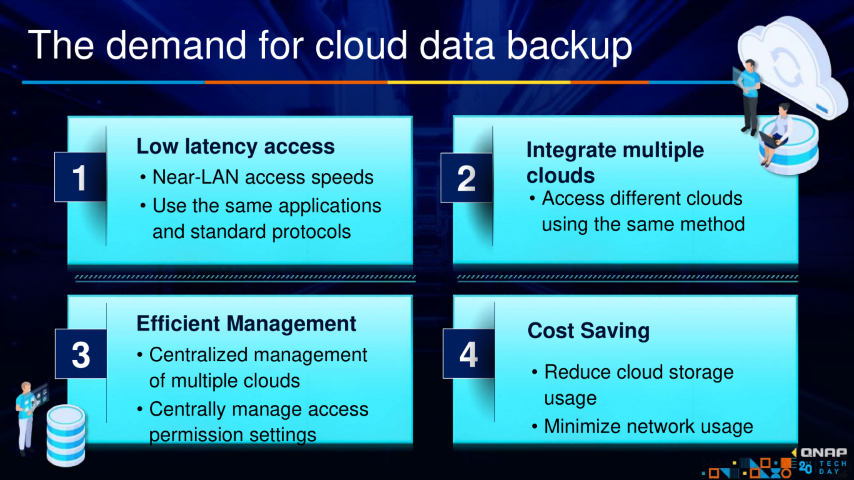
NAS Storage Benefits over Cloud
- Better Price per Terabyte Long Term
- Configurability
- FAST local/network Access (1/5/10/25/40Gbe)
- Application controlling
- Bespoke Configuration
Cloud Storage Benefits over NAS
- Easier Internet Access
- Fast Storage expandability
- Low Initial Setup Cost
Hybrid storage takes the advantages of both, whilst leveraging them against the disadvantages of the other and creating a perfect access system that suits almost all user case scenarios. With the cloud services acting as short. The Benefits of a Hybrid Storage Solution that includes both services are:
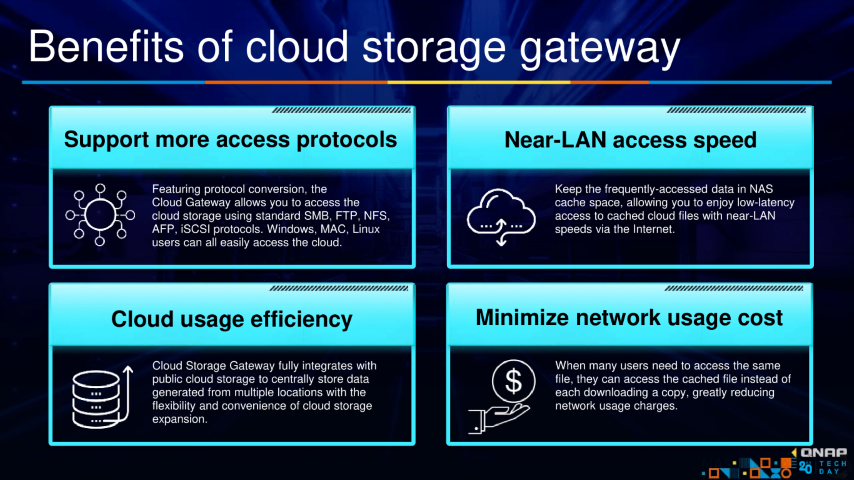
- Low Latency on Local File Access thanks to LAN connectivity
- Aggregation of multiple clouds into a single environment
- Easier to Organize Multiple Site Backups
- Remote/Internet access on Hot Data combined with automated Cold Data Backups
- Local Client Synchronization made significantly less difficult (more user-friendly)
What is QNAP HybridMount?
The new HybridMount file-based cloud gateway allows you to connect your cloud platforms (as well as NAS systems) as mounted drives on your NAS system (visible via connected NAS client applications, File Station and connected programs. Unlike the Cloud synchronization in ‘Hybrid Backup Sync 3’, this does not keep duplication of the cloud/external NAS/Server on your NAS as folders on the volume, but a separate mounted volume that is cached, taking significantly less capacity on your NAS.
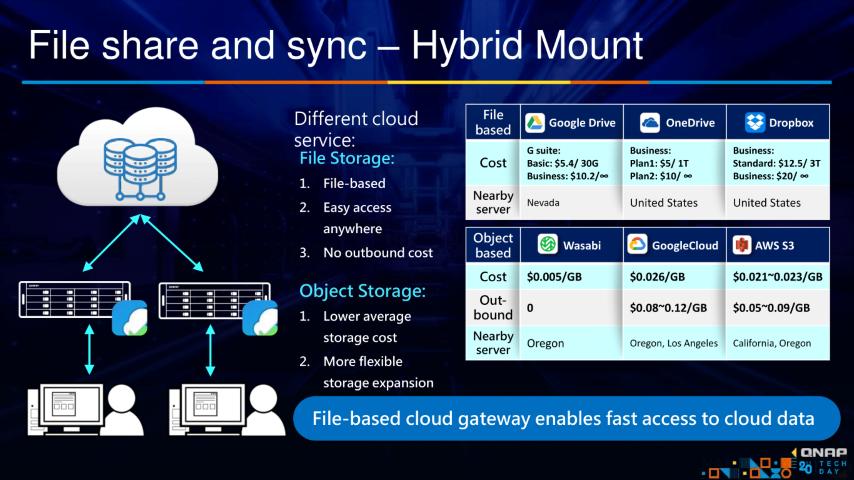
Supporting standard file server protocols, such as SMB, AFP, NFS, FTP and remote via WebDav, you can attach multiple instances of cloud provider storage to your QNAP NAS via HybridMount and interact with them as you would your regular volume. However, operations like Snapshots and restoration are not supported on behalf of this mounted cloud drive. That said, these platforms often have their own version recovery systems in place (depending on the service provider and your subscription) supporting File and/or block-level cloud services.
How to Use HybridMount on your QNAP NAS effectively
Mounting a cloud drive to your QNAP NAS using HybridMount is is fantastically easy and fast, thanks to the software caching the metadata of the cloud storage. When HybridMount works with the Cloud Storage, it initially works with the cache first, then in the background, transfers this over to the storage. That said, there are two main methods for doing so and each is designed for a different user type
File Station HybridMount Use
In this method, you can mount the cloud storage and it will be visible and accessible via the browser GUI QTS 4.4.1 and File Sation, as well as the Qfile mobile app for Android and iOS. You can mount as many as you want at no additional cost and anywhere you can access file station, you can access the mounted cloud drive. However, this kind of mount is done by the file station app and is much more dependant on your upload/download speed of your ISP – so changes/modifications to files are only as fast as your internet
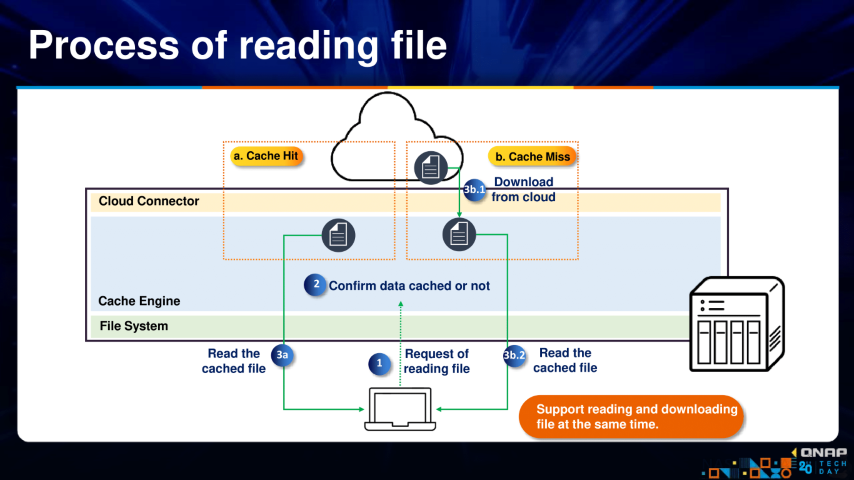
It is always worth noting that the file editing happens in real-time, so when you are editing a file that is on the Hybrid Mount, you are editing a snapshot version of the file that is still caching and syncing with the cloud service. So, remember that if this will NOT make the original file on the cloud read-only. For those looking at NLE, or non-linear editing of files (eg only editing happening on duplication of the file), you should look at cloud synchronization with applications like Hybrid Backup Sync 3.
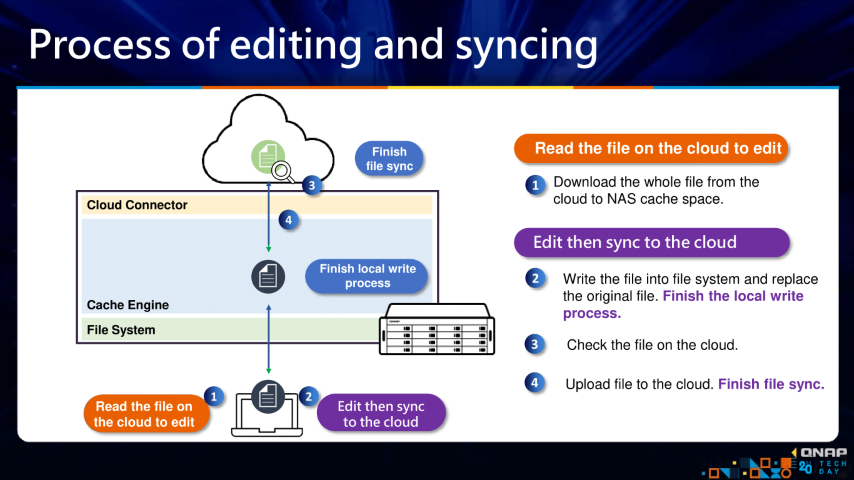
Of course, in order to process, view and interact with this amount of data, you will need sufficient cache space to complement your cloud storage. QNAP recommend 10-20% ratio of your cloud storage space to ensure it runs as smooth as possible, with the cache space being flushed as needed, as newer and more popular data arrives.
File Cloud Gateway HybridMount Use
This is a much better-equipped method of mounting your cloud storage. Supporting the same variety of cloud providers as before, this allows the storage area you create to be accessible by all the network file protocol means you can think of (SMB, AFP, NFS, FTP, WebDav), not just via File Station, mounted and visible as any volume on your NAS externally. This also means that the data can be accessed by other applications on the NAS, such as QuMagie, Qsirch and media applications.
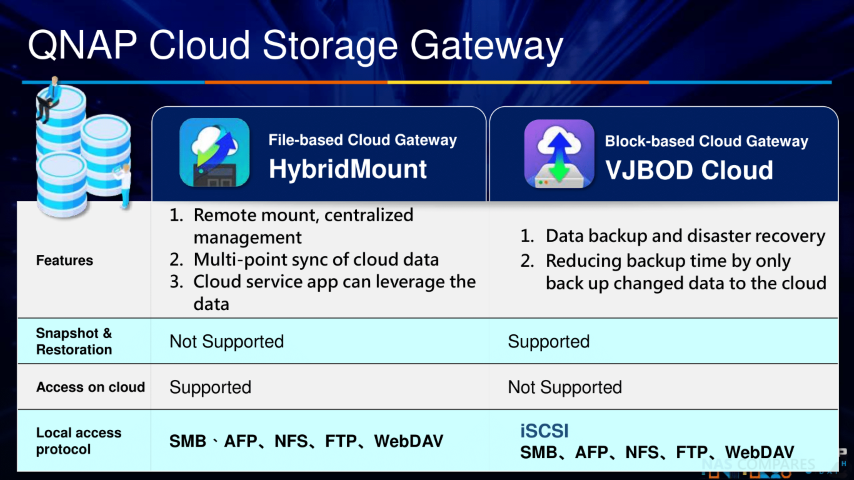
peed is much higher than the File Station mount, as the data is cached (the most common access files at the very least)– so changes are effective immediately. As you would expect from this more enterprise-level service, it is license-based, but you have two file cloud gateway licenses included with your HybridMount application with every NAS.
What is QNAP VJBOD?
Designed for data backup and disaster recovery, using local storage on the QNAP and mirror it onto the cloud/other NAS as a volume of storage. Supporting storage functionality such as snapshots and multiple versions, it acts as a great recovery from issues like malware/ransomware infection, to whole RAID failure data recovery. Although the service supports ISCSI, SMB, AFP, NFS, FTP and WebDav, it should be noted that vJBOD supports block-based storage (BackBlaze, AWS S3, etc) so it will need to be the whole system.
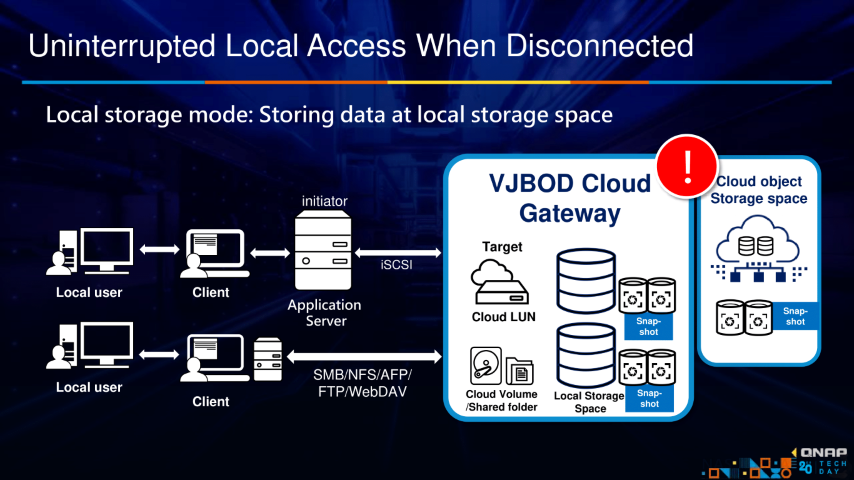
What situations will a user find vJBOD and HybridMount Most useful
Unsurprisingly, the most popular uses for these cloud-NAS gateway applications is for business users and either to reduce the network activity to multiple users or create streamlined backups that make low/zero impact on connected users
Examples One – Reducing Bandwidth Consumption of Client Users Currently on Cloud Only
If your office/business currently uses cloud services like Dropbox/Google Drive/OneDrive to synchronize data with a single business account, the result is multiple client devices (Laptops, phones, iPads, PCs, etc) all syncing over the internet individually, at the same time, constantly. The result is Heavy Upload and Download traffic on your network, reducing access and duplicating data in numerous instances.
The solution, using a QNAP NAS with HybridMount. Connect your DropBox/Google Drive/OneDrive with your QNAP NAS with HybridMount, then make the mounted cloud drive accessible to the client devices. This will result in the client devices using just the internal network (1Gbe or more depending on yoru switch etc) and then only a single instance of connectivity between your cloud and your NAS takes place. The result is reduced work on the part of your client devices (using QNAP client apps, mapped network drives, etc) and much less bandwidth consumption overall
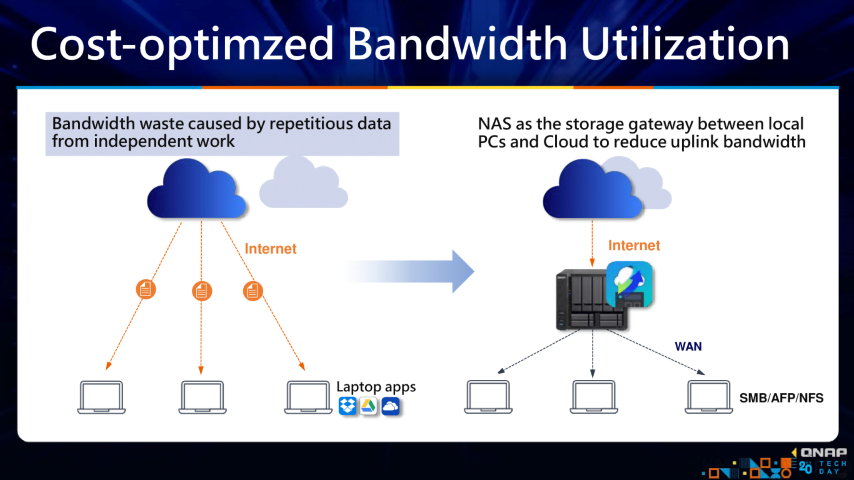
Example Two – Multi-Site Sharing with Backup, Speed, Combination Read-Only and Read-Write Access rules
A much more business-led NAS and Cloud idea is when you have large amounts of data, on multiple servers, each hundred of miles apart. You have one server that acts as the upload point of the data, and one or more servers needing access to the data. Some requiring editing rules and others with just the ability to read, but not change the file. This kind of setup often leads to HUGE capacity waste, when files are duplicated on multiple NAS, instead of just accessing remotely.
Solution. The Primary NAS where files are uploaded to a central NAS server (where data is generated), then that NAS can either use vJBOD and mount the NAS to your Cloud service, or mount the cloud service via Hybrid Mount to the NAS, then use Hybrid Backup Sync 3 (with deduplication and compression where available) to sync the data with the cloud. From there you can mount the cloud platform with a NAS in each location with HybridMount, allowing users in each location to access the data. From there you can change a number of internal settings, including making the access Read-Only in one/all locations as needed.
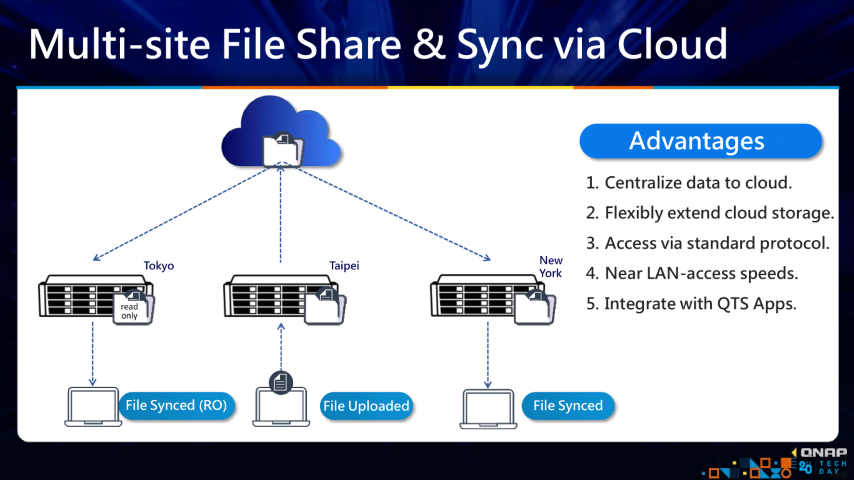
🔒 Join Inner Circle
Get an alert every time something gets added to this specific article!
This description contains links to Amazon. These links will take you to some of the products mentioned in today's content. As an Amazon Associate, I earn from qualifying purchases. Visit the NASCompares Deal Finder to find the best place to buy this device in your region, based on Service, Support and Reputation - Just Search for your NAS Drive in the Box Below
Need Advice on Data Storage from an Expert?
Finally, for free advice about your setup, just leave a message in the comments below here at NASCompares.com and we will get back to you. Need Help?
Where possible (and where appropriate) please provide as much information about your requirements, as then I can arrange the best answer and solution to your needs. Do not worry about your e-mail address being required, it will NOT be used in a mailing list and will NOT be used in any way other than to respond to your enquiry.
Need Help?
Where possible (and where appropriate) please provide as much information about your requirements, as then I can arrange the best answer and solution to your needs. Do not worry about your e-mail address being required, it will NOT be used in a mailing list and will NOT be used in any way other than to respond to your enquiry.

|
 |
Do MORE with Your M.2 Slots - GREAT M.2 Adapters!
5 Top Tips for Content Creators Buying a NAS
Terramaster F4 SSD NAS - Should You Buy? (Short Review)
Minisforum N5 Pro NAS Review - Did Minisforum just WIN at NAS?
What Can You ACTUALLY DO with HDMI on Your NAS?
Best NAS for under $499
Access content via Patreon or KO-FI


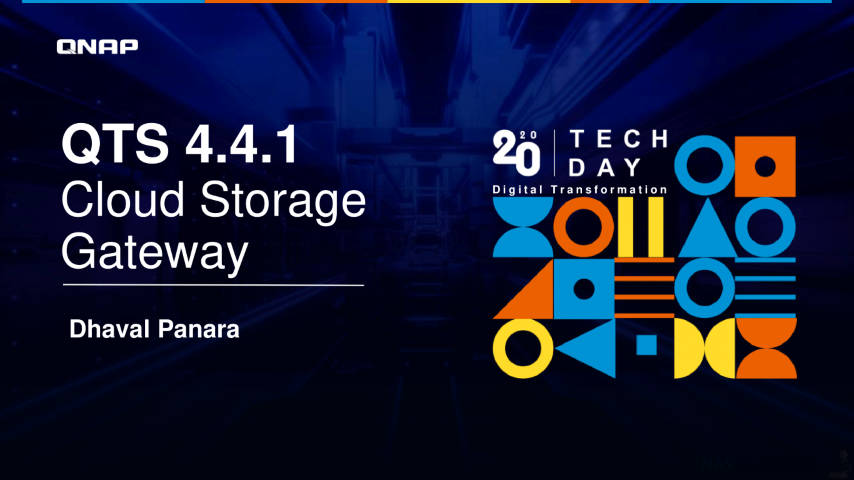



Nitip sendal
REPLY ON YOUTUBE